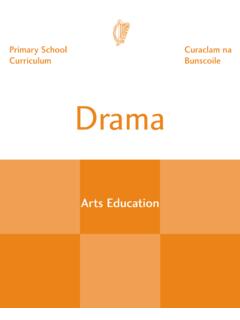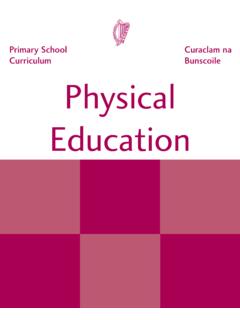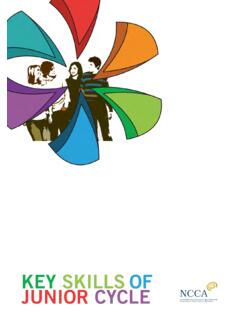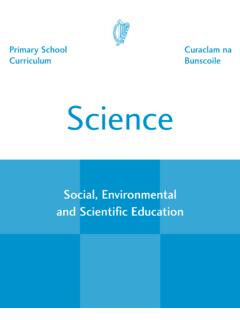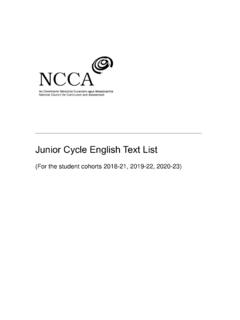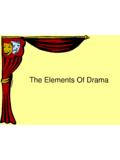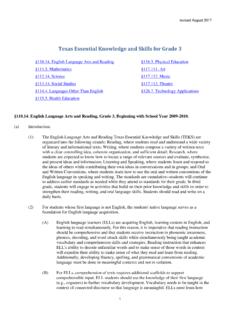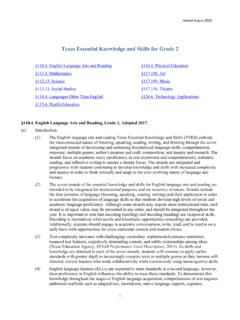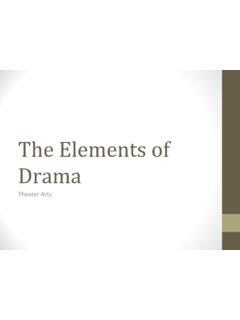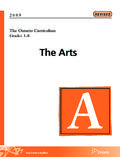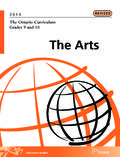Transcription of Drama - Curriculum
1 Arts EducationTeacher GuidelinesDramaPrimary SchoolCurriculumDUBLINPUBLISHED BY THE STATIONERY OFFICETo be purchased directly from theGOVERNMENT PUBLICATIONS SALE OFFICESUN ALLIANCE HOUSEMOLESWORTH STREETDUBLIN 2or by mail order fromGOVERNMENT PUBLICATIONSPOSTAL TRADE SECTION4-5 HARCOURT ROADDUBLIN 2(Tel: 01-6476834-5; Fax: 01-4752760)or through any booksellerDesign Consultancy:Bradley McGurk PartnershipDesigned by:The Identity BusinessPhotography:Christy McNamaraTypesetting:Spectrum Print ManagementPrinted by:Mozzon Giuntina - Florence andOfficine Grafiche De Agostini - Novara 1999 Government of IrelandDramaArts EducationTeacher GuidelinesContentsDrama in the primary curriculumWhat is Drama ?
2 2 The contribution of Drama to the child s development4 The content of the Drama curriculumBasic structure and layout of the curriculum8 The elements of drama8 The prerequisites for making drama9 The strand units9 School planning for dramaCurriculum planning16 Organisational planning21 Classroom planning for dramaThe general planning context for Drama in the classroom26 The content of the drama27 The integration of Drama with other Curriculum areas29 Teaching Drama to multi-class groups31 Section 1 Section 3 Section 4 Section 2 Drama Teacher GuidelinesApproaches and methodologiesMake-believe play to process drama37 The prerequisites for making drama39 The elements of drama46 Approaching a Drama activity62 Descriptions of successful Drama activities64 Examples of how content objectives in the strand units manifest themselves in the descriptions of successful Drama activities92 Drama strategies and conventions97 Looking closely at children s work99 AppendixBibliography104 Glossary108 Membership of the Curriculum Committee for Arts Education111 Membership of the Primary Co-ordinating Committee112 Acknowledgements113 Section 5 Section 6
3 Make-believe playDrama in theprimarycurriculumSection 1 What is Drama ?The essence of Drama is the making ofstory through enactment. The answer to the question what s the story? willalways lead to the making of a plot (a series of actions and events) with atheme (a focus for reflection). Successfuldrama will reflect life in a realistic ormetaphorical way and will clarifyelements of real life and point up thepatterns beneath it. The content ofdrama is, therefore, real life in all itsmanifestations, and the method bywhich it is examined is story. Themaking of this story is done through the enactment of selected significantmoments or scenes; and the selection,enactment and linking of these scenesand reflection upon them comprises the text of the Drama the context of the primary school,educational Drama is not to be confusedwith what may be termed performancedrama.
4 This activity, familiar to manyteachers, usually involves choosing ascript and cast, rehearsing, designingand building a set, organising lighting,sound and other technical features, andmounting a performance for an involved in such an experiencecan, if undertaken with a knowledge ofthe principles and practices outlined inthis Curriculum , benefit children infostering self-confidence, in giving themthe opportunity to appear on stage andin allowing them to express themselvespublicly. However, in undertaking sucha project the teacher should bear inmind that circumstances often tend tocause the overvaluing of product andthe undervaluing of Drama , as it is envisaged in the Curriculum , is a creative processthat allows children to explore the full potential of Drama as a learningexperience.
5 It is improvisational innature and has as its aim a quest forknowledge that involves every aspect ofthe child s personality: spiritual, moral,emotional, intellectual and physical. Inmaking this Drama the child enters animagined context (the Drama world),through enacting a fiction aboutcharacters in certain circumstances, at some particular time and in someparticular situation, and so can explorein a unique way conflicts, issues, conse-quences, attitudes, emotions, concernsand preoccupations that are importantto the understanding of real life. Section 1 Drama in the primary curriculumDrama in the primarycurriculum2 The developmental and learning powerof Drama lies in the particular nature ofthe dramatic experience.
6 In surrendering to the fiction projecting himself/herselfimaginatively into a situation knowing and living thecircumstances, dilemmas, choicesand actions of a fictitious character,and their consequences refracting all this through his/herown personality the child can come to new provides a unique gateway tolearning and affords a dimension ofknowledge that is otherwiseinaccessible. What is Drama ?3 Drama Teacher GuidelinesThe contribution of Drama to the child s developmentDrama can make a unique contributionto the development of the child. Itspurposes, and the particular characterof its activity, provide the means bywhich the child can achieve an enhancedawareness of self and can experience aunique mode of learning.
7 It can give each child the opportunity toapproach new knowledge throughthe dimension of imaginativeactivity and experience give each child the opportunity toapproach knowledge in the ways thatare most suitable to him/her create the motivation and interestthat can spur the child to research,and thus foster an attitude that viewsknowledge as essential in adaptinghis/her perception of the world provide the means by which thechild can relate knowledge, in aspecial way, to previous learning and experience help the child to see pattern andunity in seemingly disparate piecesof knowledge encountered indifferent subjects make distant what is close and makeclose what is distant at both acognitive and an affective level.
8 Sothat aspects of life can be exploredclosely enough to afford effectiveexamination but distant enough toprovide safety for the child give the child a rich oral languageexperience and afford the opportunityto experiment with different registersof language give the child experience of dramaas an art form help the child to assimilate andaccommodate the experience ofother cultures help the child to assimilate a changingenvironment through anticipatingpsychological development andthrough allowing him/her to transcendimmediate experience by trying outother worlds through dramaThe teacher observing simultaneous dramatic actionSection 1 Drama in the primary curriculum4 facilitate the child s imaginative,intellectual, emotional and physicaldevelopment in a contemporaneousand holistic way foster the child s creativity, invention,insight, discovery and problem-solving through exploring activelythe intuitive and the spontaneous allow the child, through thedramatic fiction, to experience,understand and practise the lifeskills needed in reality promote empathy with the ideas,attitudes and feelings of content of educational Drama islife.
9 It encompasses the entire range ofa child s experience and every facet ofhis/her personality; and because itconstitutes a unique way of learning itshould be an indispensable part of thechild s experience in contribution of Drama to the child s development5 Drama Teacher GuidelinesThe contentof the dramacurriculumSection 2 Basic structure andlayout of the curriculumLevelsThe content of the Drama Curriculum isset out in four levels: infant classes, firstand second classes, third and fourthclasses, and fifth and sixth strandThe content is presented in one strandat each level: Drama to explore feelings, knowledgeand ideas, leading to title of the strand defines thenature of Drama .
10 The learning experienceencompasses both the cognitive and the affective abilities of the child andinvolves an exploration that will lead toa greater understanding of himself/herself and of the world. Strand unitsWithin the strand the detailed elementsof content are presented in three strandunits which describe aspects of dramaexploration, experience and activity. Thestrand units are: Exploring and making Drama Reflecting on Drama Co-operating and communicating inmaking are given with each contentobjective which indicate the kind ofexplorations, experiences and activitiesthat are envisaged in it.
